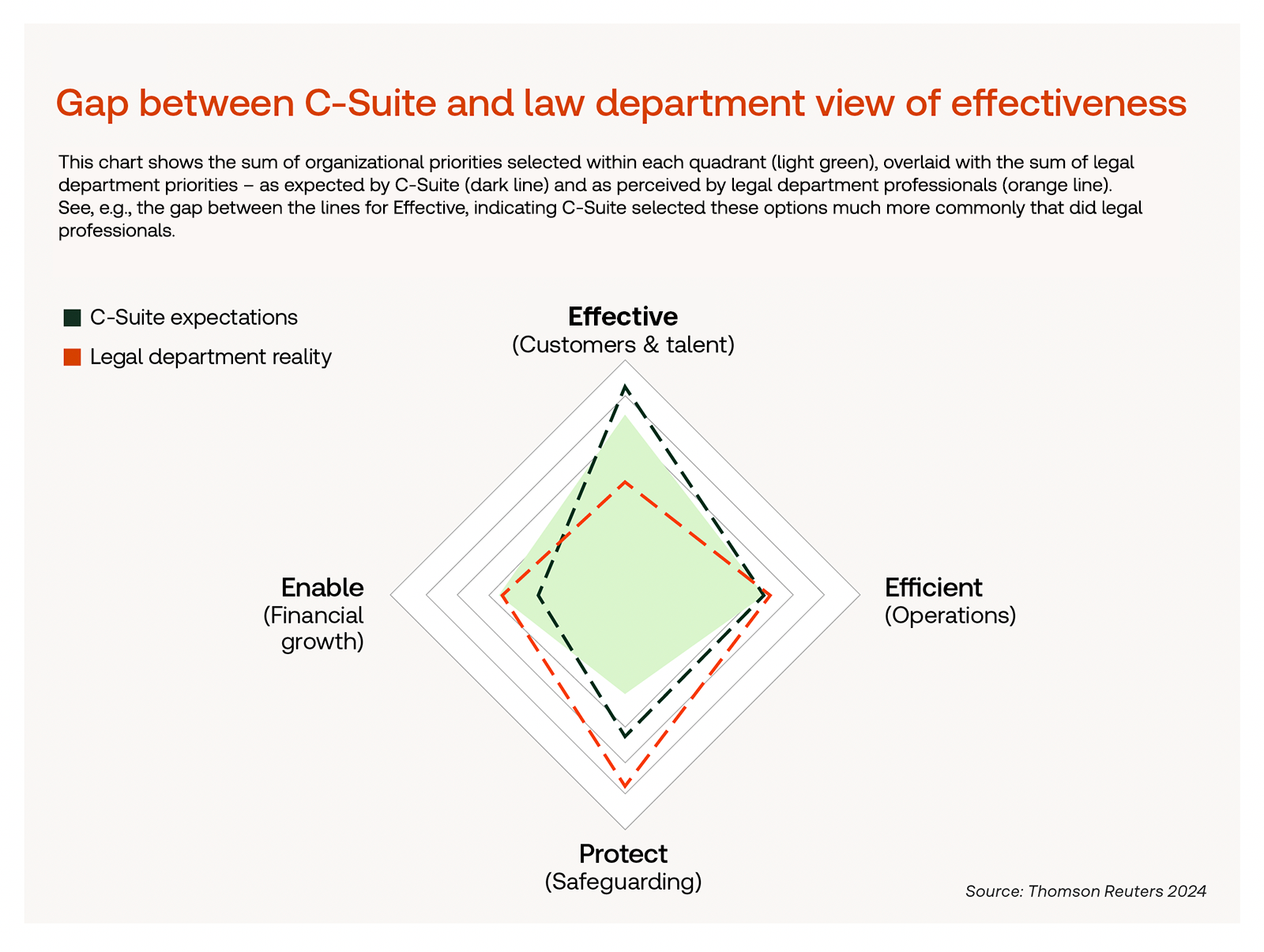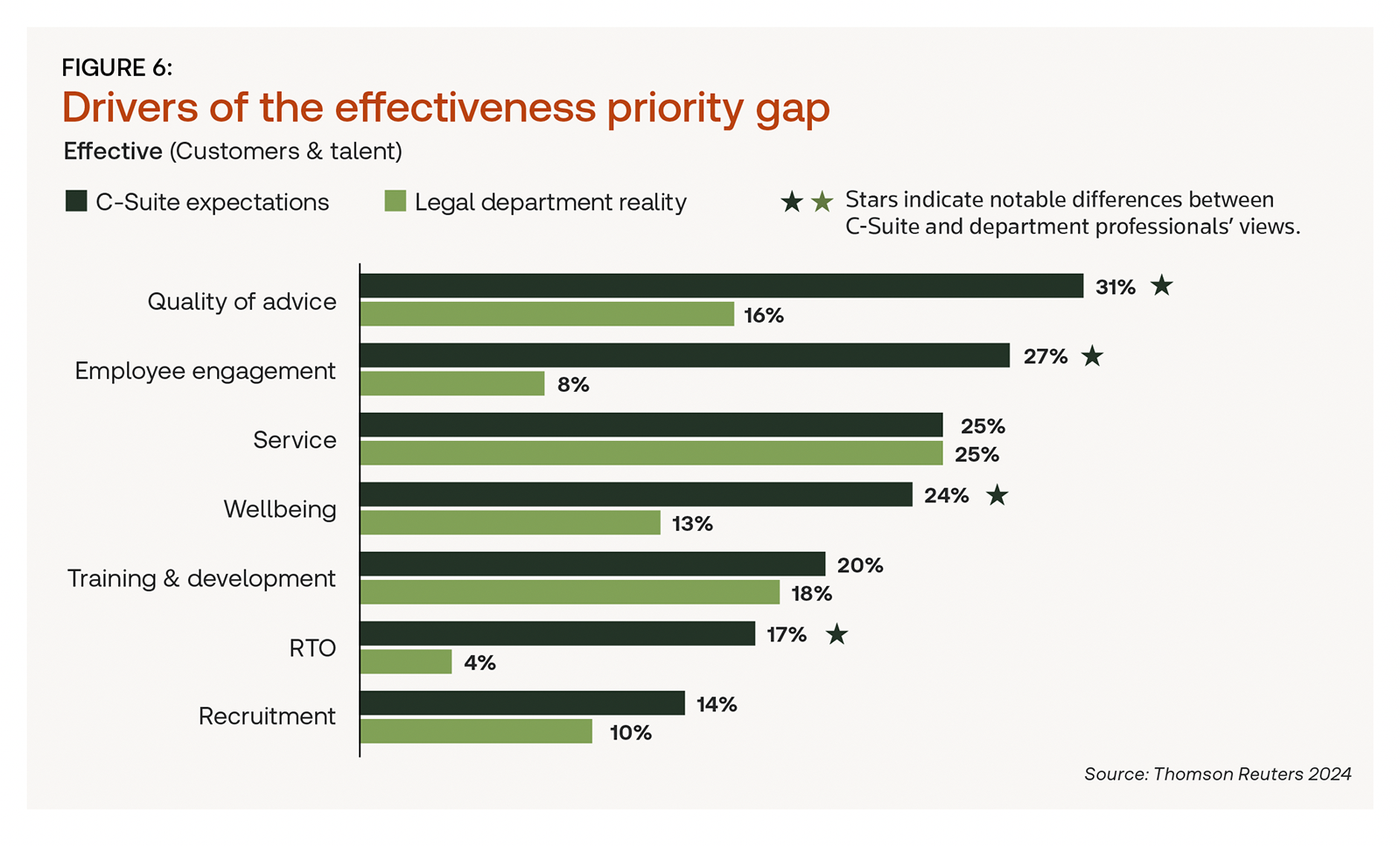General Counsel are in close alignment with what their C-Suite leaders want, but with potential areas for positive influence in perceptions
Corporate general counsel (GCs) and their C-Suite leaders naturally view the business of the enterprise, and the law department’s function within it, through their own unique lenses. We discussed this in depth in the recent 2024 State of the Corporate Law Department report, showing that in many cases, there is alignment between the priorities of GCs and the C-Suite.
In other instances, there are apparent gaps, however; but these gaps actually matter less as we dive deeper into them. Yet, some areas present true gaps in the understanding of upon which areas GCs think their departments should focus and what the C-Suite wants. This leaves the typical legal department leader with a choice: Try to craft a message to demonstrate the department’s broader alignment with enterprise goals, or craft a different message designed to influence the C-Suite’s perceptions.
Where there’s alignment
To begin this discussion, we need to lay out how the C-Suite is stating its expectations compared to how the internal legal function views its reality. There is near uniformity between both the C-Suite and GCs in their views on how important efficient operations are to the legal function of the business. This similarity is understandable, and in fact, reassuring given the high level of priority placed on budgetary accountability and cost control within the law department over the past several years. Cost control has been and remains a key area of focus for GCs, and it seems as though this is right in line with the expectations from their leadership.
There is near uniformity between both the C-Suite and GCs in their views on how important efficient operations are to the legal function of the business. This similarity is understandable, and in fact, reassuring given the high level of priority placed on budgetary accountability and cost control within the law department over the past several years. Cost control has been and remains a key area of focus for GCs, and it seems as though this is right in line with the expectations from their leadership.
Where there’s misalignment that might not be as significant
Effectiveness
There is a noticeably wide gap, however, between the C-Suite and its legal team when it comes to effectiveness. In fact, the size of the gap is potentially troubling at first glance — Why would corporate legal professionals be placing so low a priority on the effectiveness of their department in comparison to how the C-Suite characterizes it?
In truth, the gap, while wide, is not quite as significant as it may initially appear. The biggest contributor to this gap actually comes from the emphasis each group puts on the quality of advice coming from the in-house law department. It would be difficult to believe that GCs are not concerned with the quality of advice they are providing to the business. Instead, GCs likely view the quality of their advice to be, essentially, table stakes for their role within the organization and therefore not an area of high priority. If it’s something that’s done as a matter of course, it doesn’t need to be an area of particular focus anymore because it’s more of a daily reality.
It would be difficult to believe that GCs are not concerned with the quality of advice they are providing to the business. Instead, GCs likely view the quality of their advice to be, essentially, table stakes for their role within the organization and therefore not an area of high priority. If it’s something that’s done as a matter of course, it doesn’t need to be an area of particular focus anymore because it’s more of a daily reality.
Another wide gap can be found in return-to-office (RTO) policies. Here too, the gap is understandable. The C-Suite is tasked with setting and managing RTO policies for the entire business; GCs, on the other hand, are often less concerned with setting policy than with ensuring compliance and enforcement. Therefore, it is understandable that RTO policies would be less of a top-of-mind priority for GCs.
However, there are components to this gap that GCs would do well to remember, particularly as they relate to talent issues. Indeed, the C-Suite is demonstrating a much higher degree of expectation around employee engagement and well-being than are in-house legal teams. Yet, this can be an opportunity for GCs to show their alignment with enterprise priorities by reporting how they are managing and improving employee engagement and well-being issues within their departments.
Protection
Much like effectiveness, there was also a gap between the perspectives of the C-Suite and the law department when it comes to protection, albeit in the opposite direction. Here, GCs are actually placing greater emphasis on protecting the business than the C-Suite would necessarily expect. This is not a bad thing. In fact, the gap may reflect a reality in which the GC and legal team does such a good job of understanding and mitigating the full spectrum of risk that the C-Suite might not actually be fully aware of all potential risks, simply because these risks don’t evolve into crises that need C-Suite attention. In fact, such an outcome — one in which nothing much happens, crisis-wise — would be a testament to the risk-management abilities of the GC.
However, GCs should also be aware that they may be more sensitive to potential risk than their C-Suite and exercise caution to not allow this heightened perception to stand in the way of progress for the business. Managing risk, without doubt, is a core function for the GC, and the most effective GCs will be able to balance managing risk without their department falling into the trap of becoming the dreaded Department of No — a function that other units in the organization are hesitant to engage because of the negative impacts on progress and growth. Instead, GCs should use their heightened focus on protecting the business to transform their function into the Department of How, presenting less risky options to drive the business forward.
Where there’s misalignment that could be a benefit
Which brings us to the third alignment consideration between GCs and the C-Suite — the situations in which GCs can craft messages that might help to shape the C-Suite’s perceptions.
GCs view themselves as having a higher potential for helping to enable the business than does the C-Suite, which too often fails to credit the department for this task. Specifically, GCs believe they can play a larger role in enabling growth and that shifting toward a Department of How can play a large role in this enabling function as well. As the report states, the law department can be a place where growth can run into roadblocks, or it can be a place that helps find a smoother path around those roadblocks. By consistently focusing on becoming the latter, GCs can show their commitment to helping drive the business forward.
At the same time, if properly messaged to the C-Suite, GCs can use these efforts to shape the perception within the C-Suite of the legal function’s ability to help drive growth, pushing the GC into a role as a more vital strategic leader within the overall business.
We will likely never see a scenario in which GCs and the C-Suite are in perfect alignment in all facets of the GC’s function. However, the gaps between what the C-Suite would like to see out of its in-house law department and what that law department views as its reality can provide invaluable opportunities for growth within the department itself and can help to shape how the law department is perceived and valued across the entire business.







